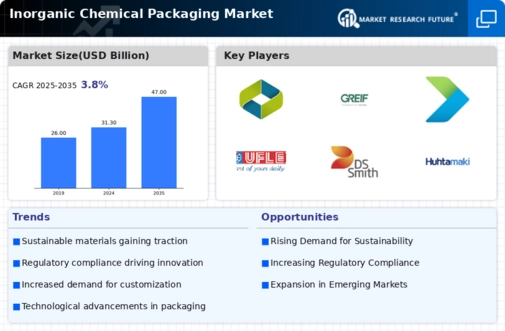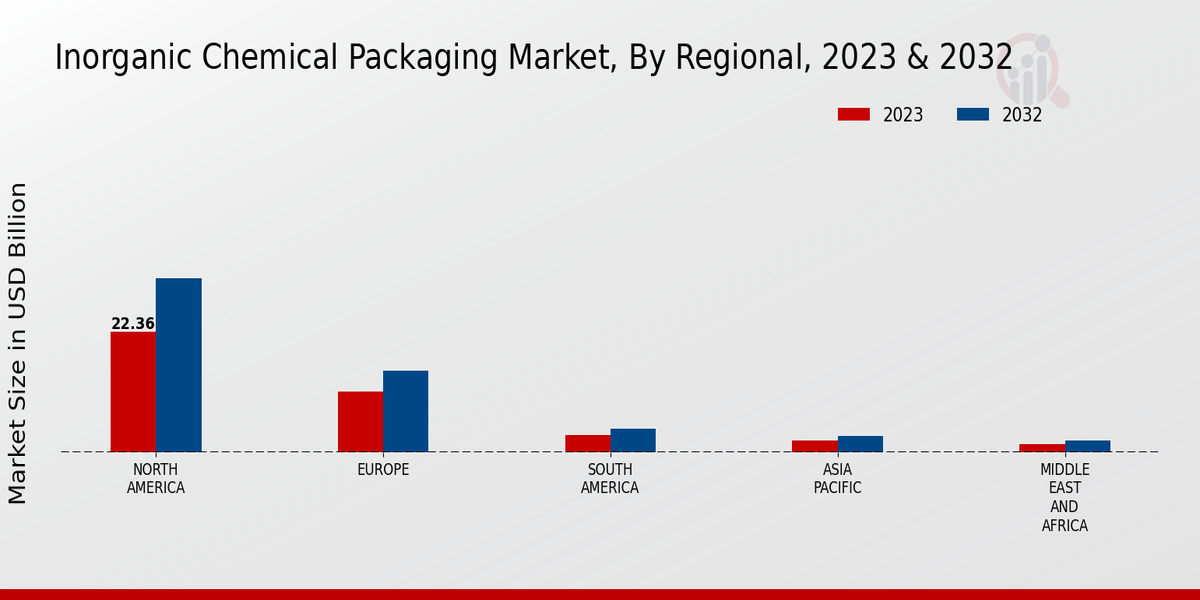Market Growth Projections
The Global Inorganic Chemical Packaging Market Industry is projected to exhibit a compound annual growth rate (CAGR) of 3.76% from 2025 to 2035. This growth trajectory indicates a steady increase in demand for packaging solutions tailored to inorganic chemicals, driven by various factors such as regulatory compliance, technological advancements, and sustainability trends. The market is expected to evolve in response to these dynamics, with companies investing in innovative packaging solutions to meet the changing needs of consumers and industries. This positive outlook suggests a robust future for the inorganic chemical packaging sector.
Sustainability Trends in Packaging
Sustainability trends are increasingly shaping the Global Inorganic Chemical Packaging Market Industry, as consumers and businesses alike prioritize eco-friendly practices. The shift towards sustainable packaging materials, such as biodegradable plastics and recyclable options, reflects a broader commitment to reducing environmental impact. Companies are responding by developing packaging solutions that align with these sustainability goals, which may enhance their market appeal. As the industry adapts to these trends, it is likely to witness a shift in consumer preferences, further driving demand for sustainable packaging solutions.
Rising Demand for Inorganic Chemicals
The Global Inorganic Chemical Packaging Market Industry experiences a notable surge in demand for inorganic chemicals, driven by their extensive applications across various sectors such as agriculture, pharmaceuticals, and construction. As industries increasingly rely on these chemicals for production processes, the packaging solutions must adapt to ensure safety and compliance. The market is projected to reach 31.3 USD Billion in 2024, reflecting a growing recognition of the importance of effective packaging in maintaining product integrity. This trend indicates a robust growth trajectory, with the industry poised to capitalize on the expanding applications of inorganic chemicals.
Regulatory Compliance and Safety Standards
In the Global Inorganic Chemical Packaging Market Industry, stringent regulatory compliance and safety standards play a pivotal role in shaping packaging solutions. Governments worldwide are implementing regulations to ensure the safe handling and transportation of hazardous materials. This necessitates the development of specialized packaging that meets safety criteria, thereby driving innovation within the industry. As companies strive to adhere to these regulations, the demand for compliant packaging solutions is expected to rise. This trend not only enhances safety but also fosters consumer confidence, ultimately contributing to the market's growth.
Growth of the Chemical Manufacturing Sector
The Global Inorganic Chemical Packaging Market Industry is closely linked to the growth of the chemical manufacturing sector, which is anticipated to expand significantly in the coming years. As the demand for various inorganic chemicals increases, manufacturers are investing in advanced production facilities, thereby necessitating efficient packaging solutions. This growth is projected to contribute to the market's expansion, with estimates suggesting a rise to 47.0 USD Billion by 2035. The correlation between manufacturing growth and packaging demand underscores the importance of innovative solutions that can accommodate the evolving needs of the industry.
Technological Advancements in Packaging Solutions
Technological advancements significantly influence the Global Inorganic Chemical Packaging Market Industry, as innovations in materials and design enhance packaging efficiency and sustainability. The introduction of smart packaging technologies, such as sensors and tracking systems, allows for real-time monitoring of chemical conditions, thereby improving safety and reducing waste. These advancements are likely to attract investments, as companies seek to differentiate their products in a competitive market. The integration of eco-friendly materials further aligns with global sustainability goals, potentially expanding market opportunities and driving growth in the coming years.























Leave a Comment